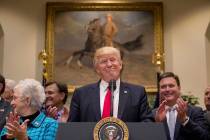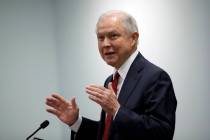Clinton, Trump lead — for now
With both presidential nomination contests having been scrambled by recent events — the FBI taking control of Hillary Clinton’s private email server and a raucous, roiling GOP debate — the third edition of the Racing Form is herewith rushed into print.
Legal disclaimer: This column is for betting purposes only. What follows is analysis — scrubbed, as thoroughly as a Clinton server, of advocacy. (Unless I simply can’t resist.)
Hillary Clinton: Ever since her disastrous book-launch performance, I’ve thought her both (1) a weak candidate and (2) the inevitable Democratic nominee.
No longer. She has fallen from her 95 percent barring-an-act-of-God perch. The email imbroglio has already badly damaged her credibility. But now that she’s lost control of the server, there is potential for further, conceivably fatal, damage. It hinges largely on how successful she was in erasing the 32,000 emails she unilaterally deemed private.
Whatever happens, she will stay in the race. Clintons never quit. But if more top-secret information is found, if she did destroy work-related emails and if her numbers continue their steady decline, the party might decide it simply can’t afford to continue carrying her baggage.
Odds: 1-3.
Bernie Sanders: A less flighty, more serious Gene McCarthy. Fiery and genial, Sanders is the perfect protest candidate. But can a 73-year-old dairy-state Brooklynite socialist win? Of course not. If Hillary falls, Joe Biden fills the vacuum. Possibly even John Kerry. (Note to Dems: The beatified Jon Stewart is currently unemployed and at large.)
Meanwhile, over at the GOP …
Donald Trump: Clear front-runner. Are you waiting for him to bring himself down? He won’t. He’s impervious to the gaffe. In fact, he has a genius for turning a gaffe into a talking point, indeed, a rallying cry.
Since the debate, his numbers have plateaued and in some places declined. In New Hampshire, for example, he’s gone from the mid-20s to the high teens. And he had a rough debate, as reflected in the Suffolk University poll in Iowa taken right afterward, in which, by 55-23, respondents felt less comfortable with him as president.
Nonetheless, his core support, somewhere around 20 percent (plus or minus a couple), remains as solid as that once commanded by Ron Paul and Ross Perot. Which means Trump will likely continue to lead until the field whittles down to a handful, at which point 20 percent is no longer a plurality.
Teflon Don. Solid constituency, fixed ceiling. Chances of winning his party’s nomination? About the same as Sanders winning his.
Jeb Bush, Scott Walker, Marco Rubio: Still the top tier. Walker just held his own in the debate. Bush slipped slightly, appearing somewhat passive and, amazingly, still lacking a good answer to the “brother’s war” question. But he continues steady with a serious follow-up foreign policy speech and stick-to-his-guns positions on Common Core and immigration — not easy given the current mood of the party.
Rubio had the best debate performance of the prime-time 10 — fluid, passionate, in command. And he was already No. 1 in the “who could you support” question (at 62 percent), crucial in a 17-member field.
Odds for each? Rubio 3-1. Bush and Walker 4-1.
Ted Cruz, John Kasich, Carly Fiorina: The new second tier. And rising. Cruz had a strong debate, establishing himself as the most convincing carrier of the populist, anti-Washington meme.
Kasich was engaging and compelling as the bleeding-heart conservative and successful tough-guy governor. Not an easy trick.
Fiorina displayed raw talent that surprised everyone who didn’t know her — and 6 million watched the undercard debate. Articulate, knowledgeable and relentlessly combative, she took on Clinton, Trump and Barack Obama. Being in the undercard was a stroke of luck. She took the stage and made it her own.
Odds for the second tier? 9-1, but with high ceilings for each.
Bonus: the general election.
Conventional wisdom is that the GOP is tearing itself apart and headed south. What’s becoming clear, however, is that the Democrats are equally split ideologically — Clinton desperately moving left as Sanders’ crowds grow — and increasingly nervous about her chronic, shall we say, character problem.
Both parties limp into November 2016. Current odds? GOP: 55 percent.
And note how thin is the Democrat’s bench. After Clinton, no one, while the GOP stage sports perhaps eight to 10 impressive, plausibly presidential figures, including (for those who count such things) two Hispanics, a female former Fortune 500 CEO and an African-American brain surgeon.
And one white guy fluent in Spanish. Try engaging Bernie or Hill en español.
Charles Krauthammer (letters@charleskrauthammer.com) is a Washington Post columnist.












